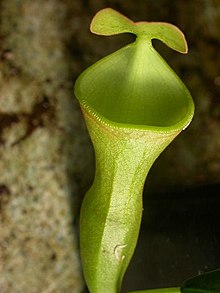
Nepenthes villosa, or the villose pitcher-plant, is a tropical pitcher plant endemic to Mount Kinabalu and neighbouring Mount Tambuyukon in northeastern Borneo. It grows at higher elevations than any other Bornean Nepenthes species, occurring at elevations of over 3,200 m (10,500 ft). Nepenthes villosa is characterised by its highly developed and intricate peristome, which distinguishes it from the closely related N. edwardsiana and N. macrophylla.

Nepenthes tentaculata, or the fringed pitcher-plant, is a tropical pitcher plant with a wide distribution across Borneo and Sulawesi. It grows at altitudes of 400–2550 m.
Shigeo Kurata is a Japanese botanist and Nepenthes taxonomist whose work in the 1960s and 1970s contributed much to the current popularity of these plants. His best-known work is the 1976 guide Nepenthes of Mount Kinabalu. Nepenthes kurata was named in his honour.

Nepenthes lowii, or Low's pitcher-plant, is a tropical pitcher plant endemic to Borneo. It is named after Hugh Low, who discovered it on Mount Kinabalu. This species is perhaps the most unusual in the genus, being characterised by its strongly constricted upper pitchers, which bear a greatly reduced peristome and a reflexed lid with numerous bristles on its lower surface.
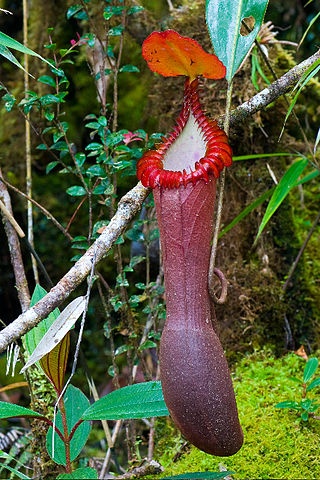
Nepenthes edwardsiana, or the splendid pitcher-plant, is a carnivorous tropical pitcher plant endemic to Mount Kinabalu and neighbouring Mount Tambuyukon in Sabah, Malaysian Borneo. It is considered one of the most spectacular of all Nepenthes, producing some of the largest pitchers and the most highly developed peristome ribs of any species in the genus.

Nepenthes fusca, or the dusky pitcher-plant, is a tropical pitcher plant endemic to Borneo. It is found throughout a wide altitudinal range and is almost always epiphytic in nature, primarily growing in mossy forest.

Nepenthes stenophylla, or the narrow-leaved pitcher-plant, is a tropical pitcher plant endemic to Borneo. The species produces attractive funnel-shaped pitchers up to 25 cm high. It is listed as Least Concern on the IUCN Red List. Nepenthes stenophylla belongs to the loosely defined "N. maxima complex", which also includes, among other species, N. boschiana, N. chaniana, N. epiphytica, N. eymae, N. faizaliana, N. fusca, N. klossii, N. maxima, N. platychila, and N. vogelii.
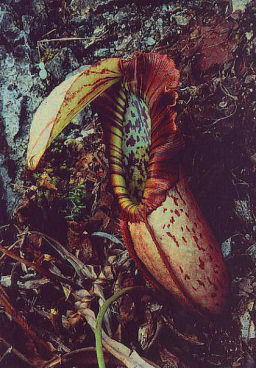
Nepenthes northiana, or Miss North's pitcher-plant, is a tropical pitcher plant endemic to Borneo, where it grows at elevations ranging from 0 to 500 m above sea level. The specific epithet northiana honours the English botanic illustrator Marianne North, who first depicted the species. Nepenthes northiana is one of the most famous Nepenthes, and its discovery in the latter half of the 19th century contributed to Sarawak's reputation as a land of spectacular exotic plants.

Nepenthes clipeata, or the shield-leaved pitcher-plant, is a tropical pitcher plant known only from the near-vertical granite cliff faces of Mount Kelam in West Kalimantan, Indonesia. It has an elevational distribution between approximately 600 and 800 m.

Nepenthes pilosa is a tropical pitcher plant endemic to Borneo. It is characterised by a dense indumentum of long yellow-brown hairs. Pitchers have a distinctive hook-shaped appendage on the underside of the lid. The specific epithet derives from the Latin word pilosus, meaning "hairy".
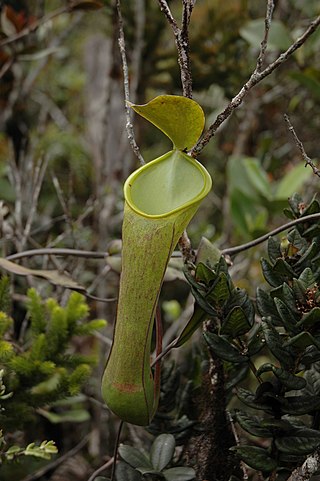
Nepenthes murudensis, or the Murud pitcher-plant, is a tropical pitcher plant endemic to Mount Murud in Borneo, after which it is named. It is of putative hybrid origin: its two original parent species are thought to be N. reinwardtiana and N. tentaculata.
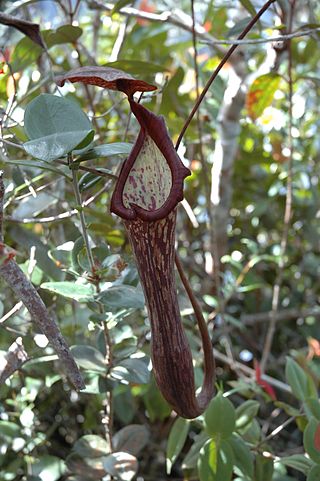
Nepenthes faizaliana is a tropical pitcher plant endemic to the limestone cliffs of Gunung Mulu National Park in Sarawak, Borneo. It is thought to be most closely related to N. boschiana.

Nepenthes mapuluensis, the Mapulu pitcher-plant, is a species of tropical pitcher plant native to East Kalimantan, Borneo. It is known only from a restricted geographical range and is listed as Endangered on the IUCN Red List.
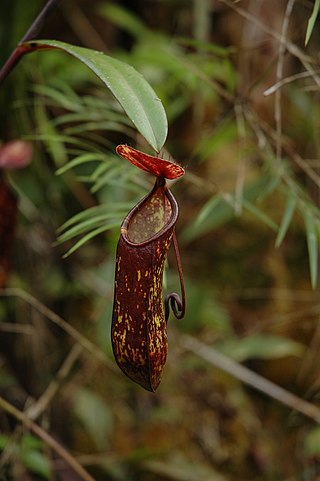
Nepenthes muluensis, or the Mulu pitcher-plant, is a tropical pitcher plant endemic to Borneo. It grows in highland habitats at elevations of 1700 to 2400 m above sea level.

Nepenthes vogelii is a tropical pitcher plant endemic to Borneo. It is thought to be most closely related to N. fusca.

Nepenthes platychila is a tropical pitcher plant endemic to the Hose Mountains of central Sarawak. It is notable for its smooth peristome and funnel-shaped upper pitchers. Nepenthes platychila belongs to the loosely defined "N. maxima complex", which also includes, among other species, N. boschiana, N. chaniana, N. epiphytica, N. eymae, N. faizaliana, N. fusca, N. klossii, N. maxima, N. stenophylla, and N. vogelii.
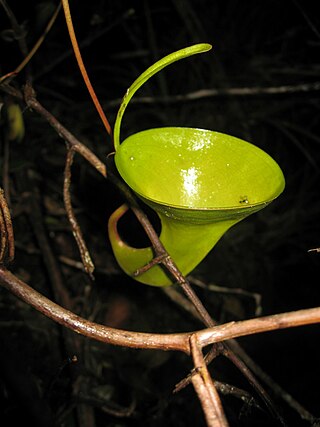
Nepenthes inermis is a tropical pitcher plant endemic to the Indonesian island of Sumatra. The specific epithet inermis is Latin for "unarmed" and refers to the upper pitchers of this species, which are unique in that they completely lack a peristome.
Ch'ien C. Lee is a photographer and botanist specialising in the carnivorous plant genus Nepenthes. Lee has described several new Nepenthes species, including N. baramensis, N. chaniana, N. gantungensis, N. glandulifera, N. jamban, N. lingulata, N. palawanensis, N. pitopangii, N. platychila, and N. harauensis. Lee also described the natural hybrid N. × bauensis.

Nepenthes chaniana is a tropical pitcher plant species belonging to the genus Nepenthes. It is characterised by a dense indumentum of long, white hairs. Pitchers are cylindrical and mostly white to yellow in colouration. Nepenthes chaniana belongs to the loosely defined "N. maxima complex", which also includes, among other species, N. boschiana, N. epiphytica, N. eymae, N. faizaliana, N. fusca, N. klossii, N. maxima, N. platychila, N. stenophylla, and N. vogelii.

Mount Ilas Bungaan is a limestone hill near Berau, East Kalimantan, Borneo. It is also known as Flowering Rock, a literal translation of its Indonesian name. The hill is located "on a remote stretch of the Karangan River" and its base lies at an altitude of around 300 m.
